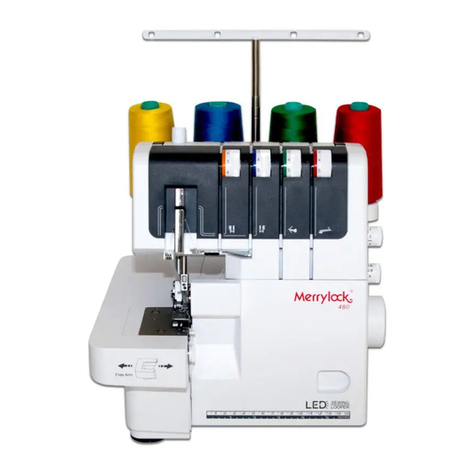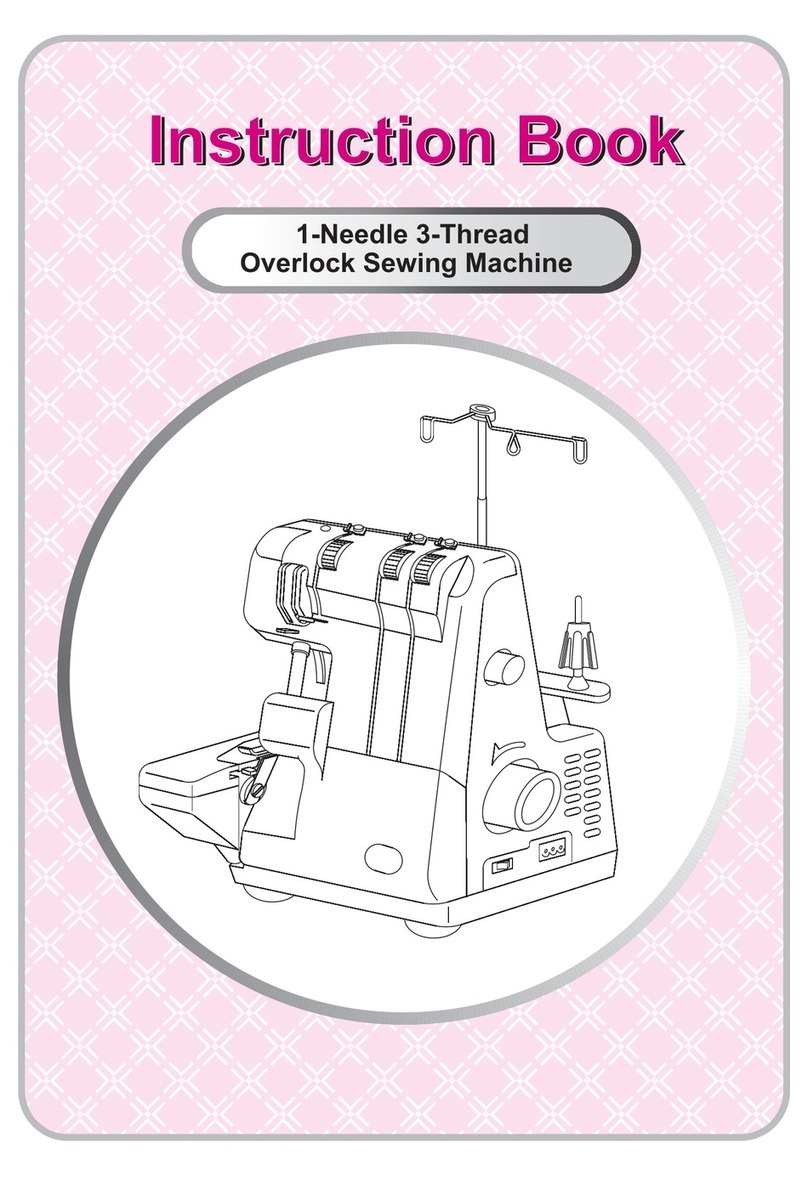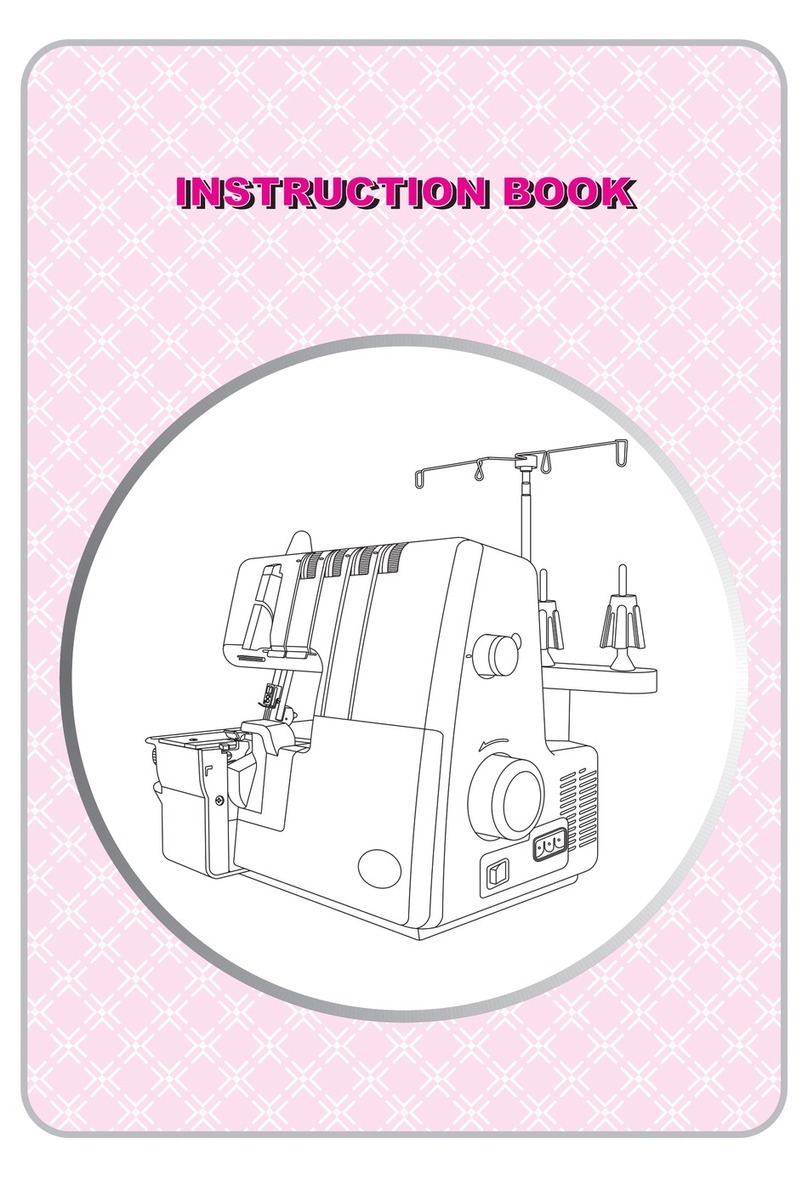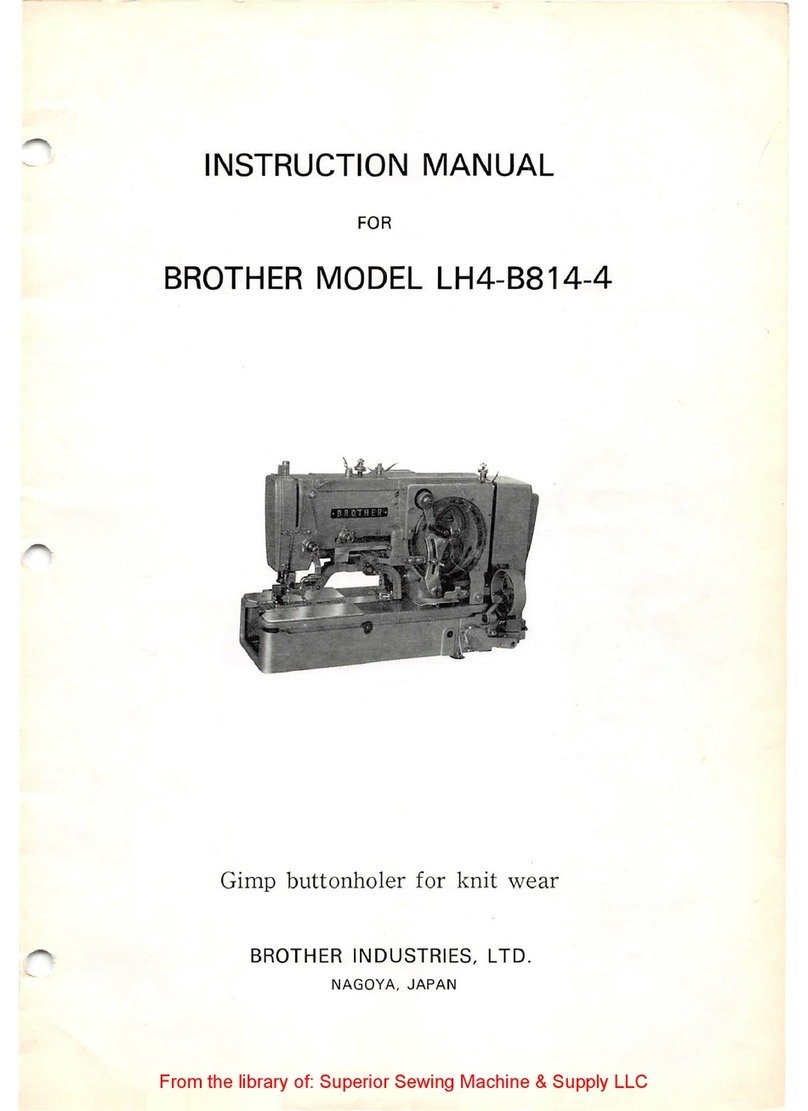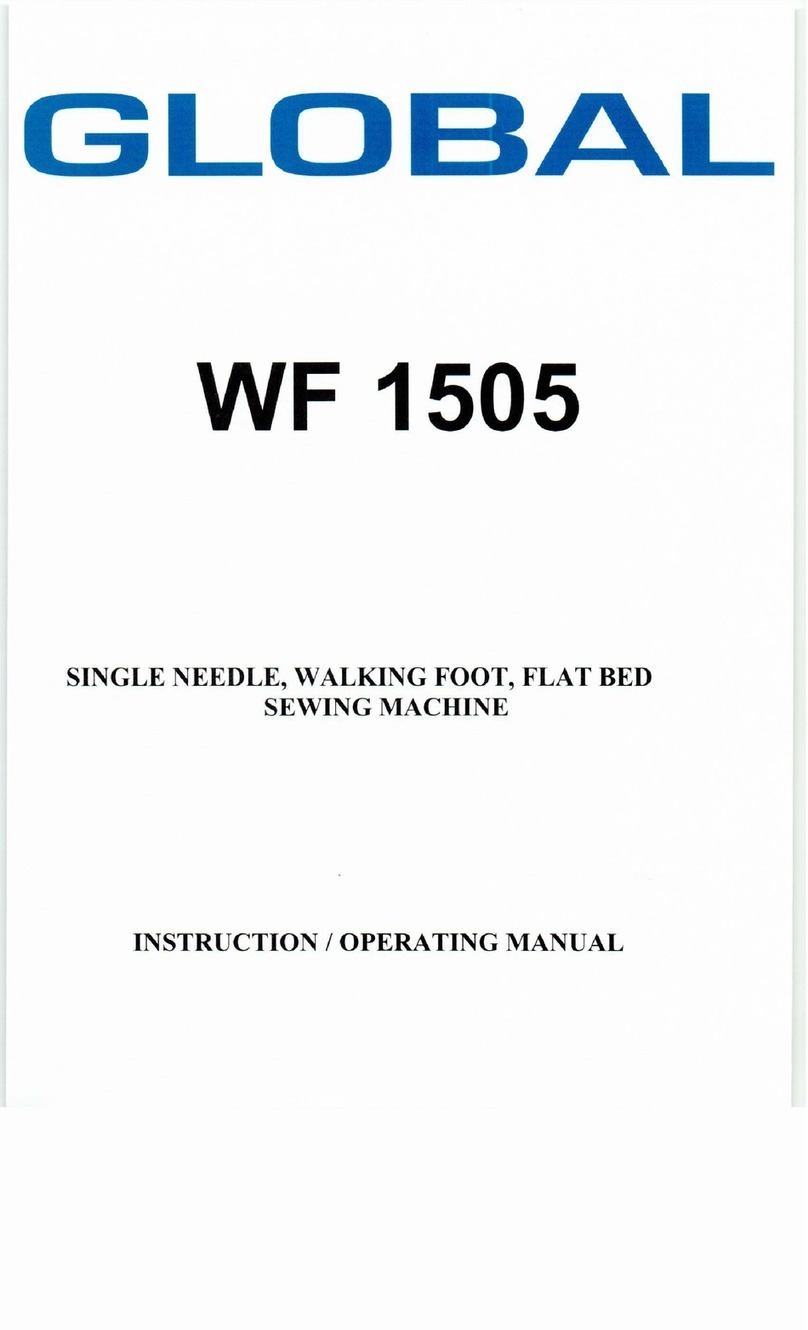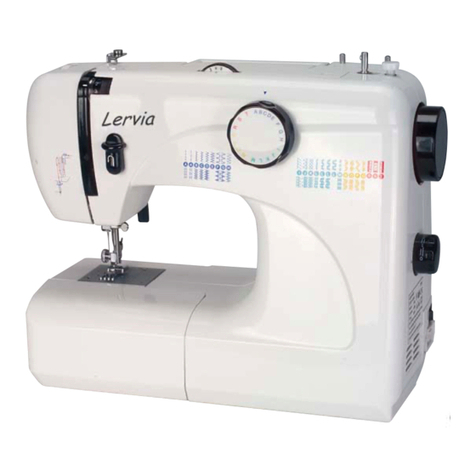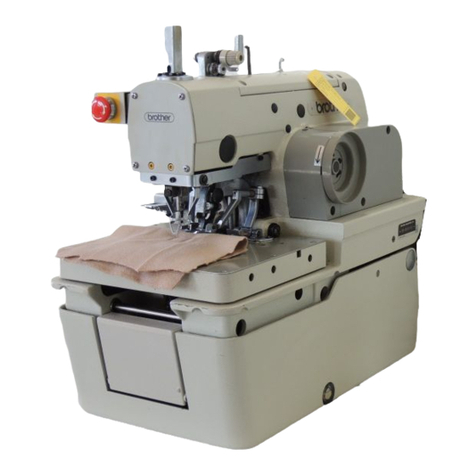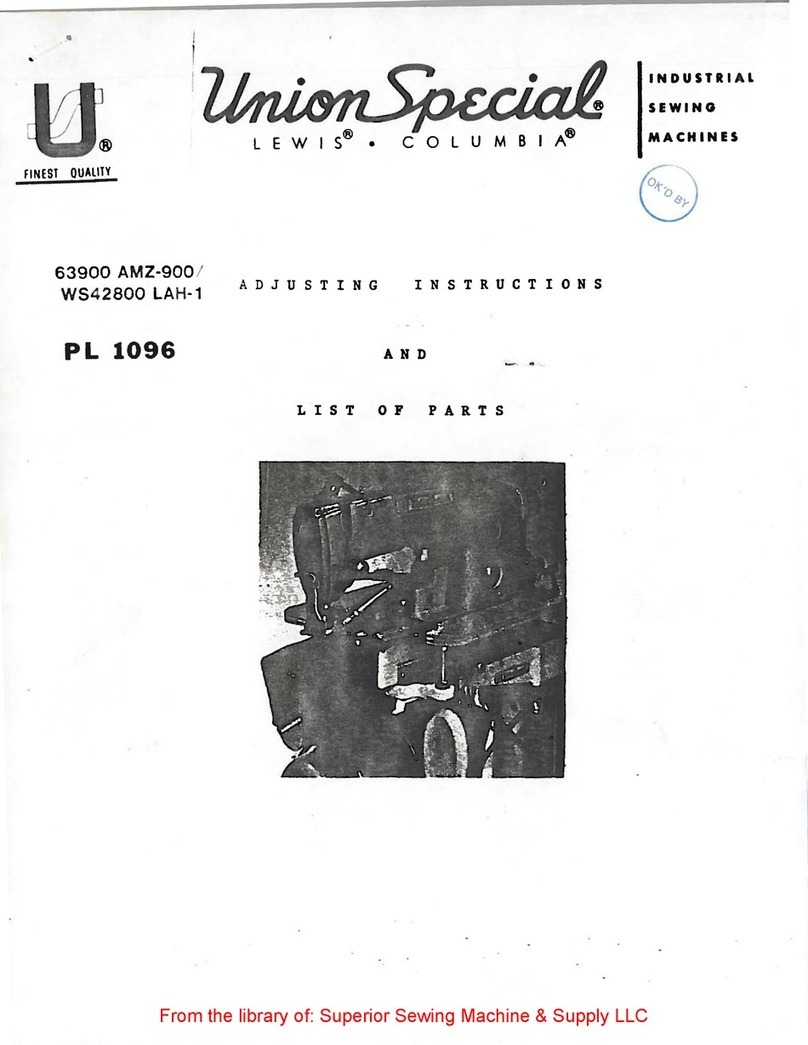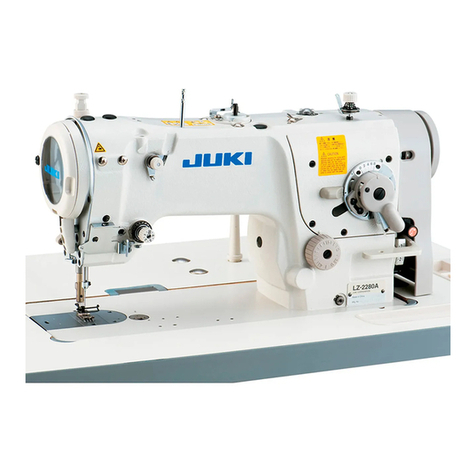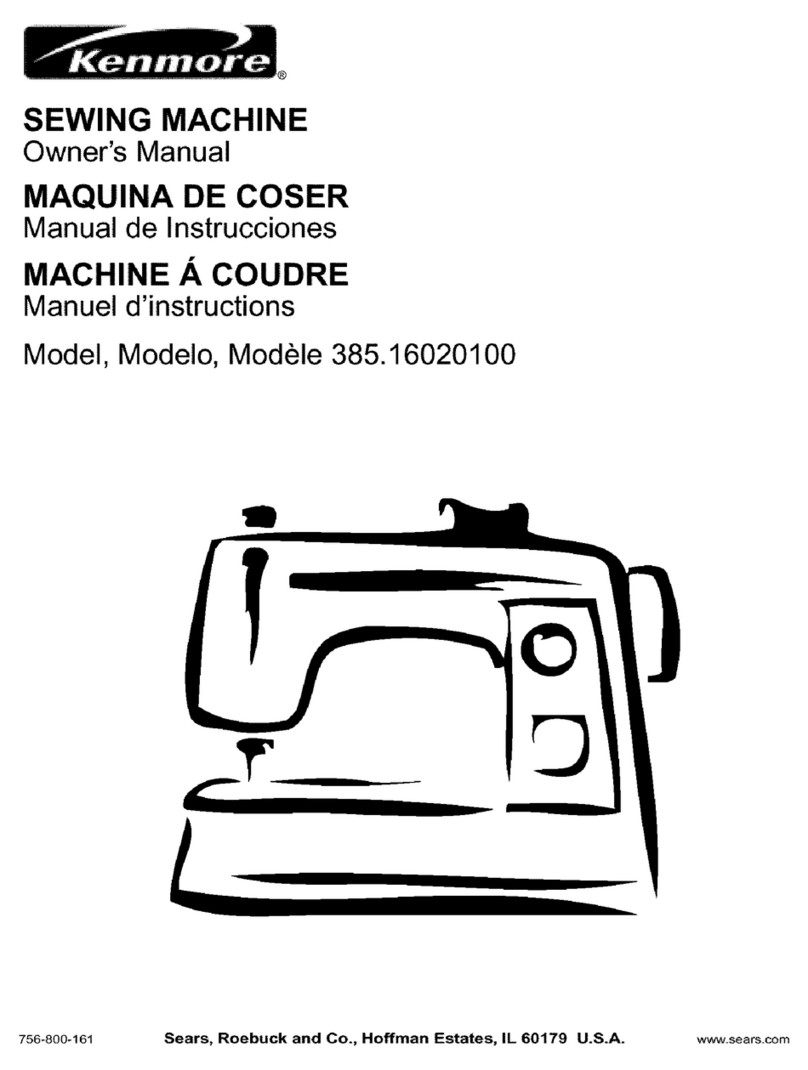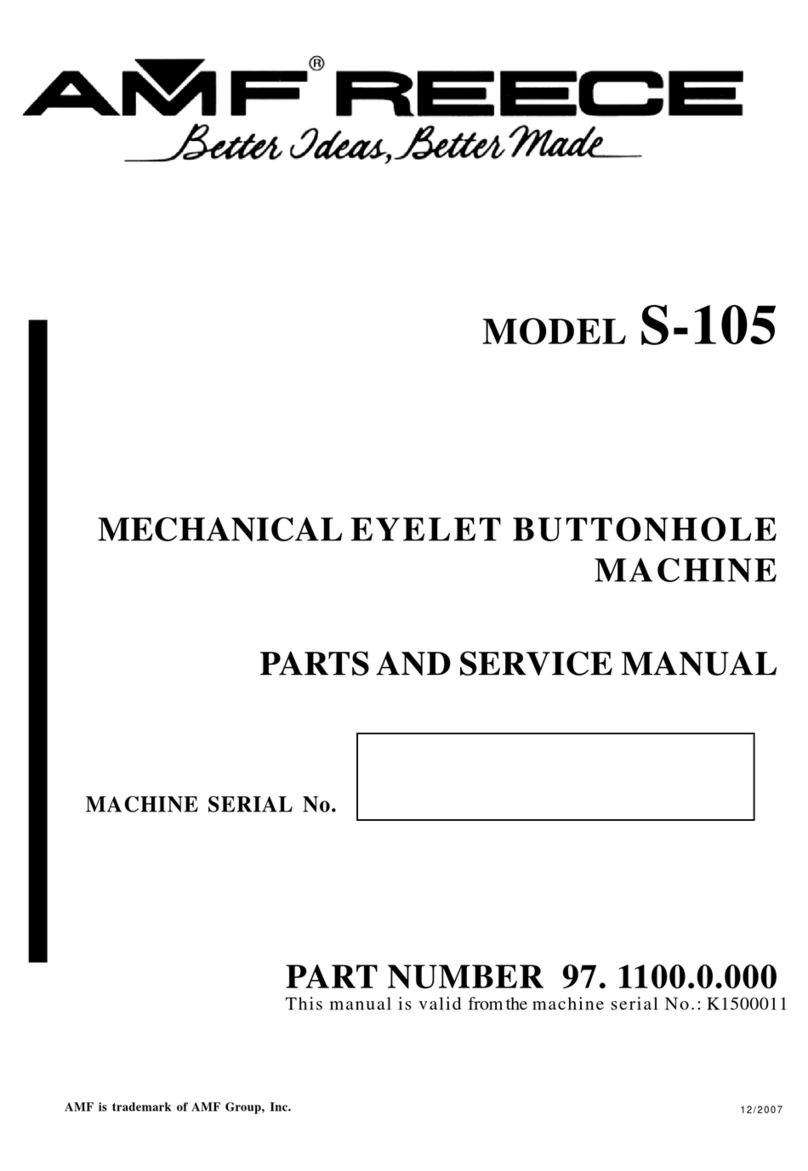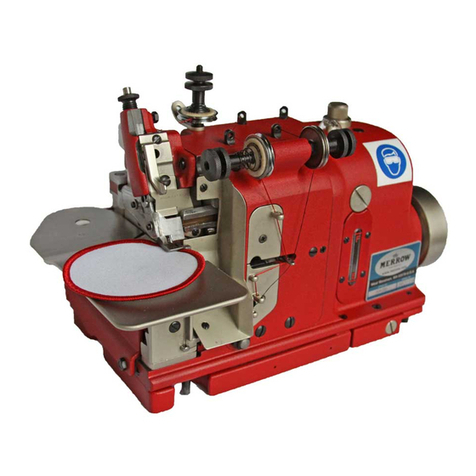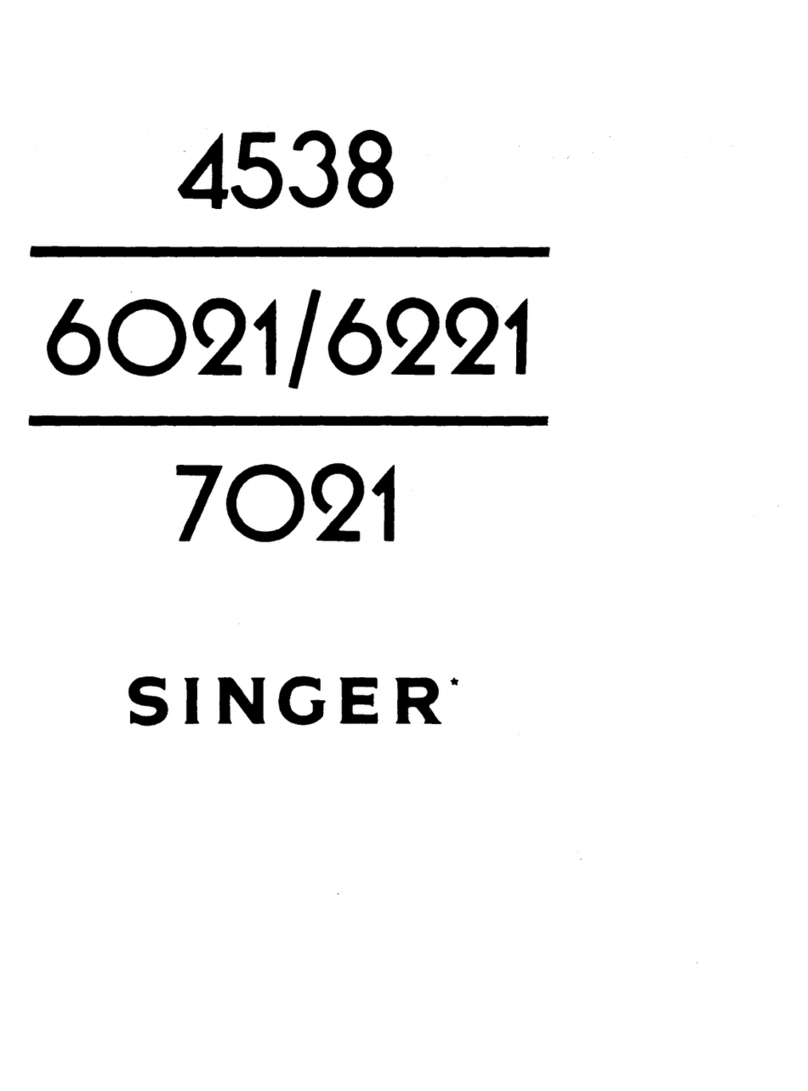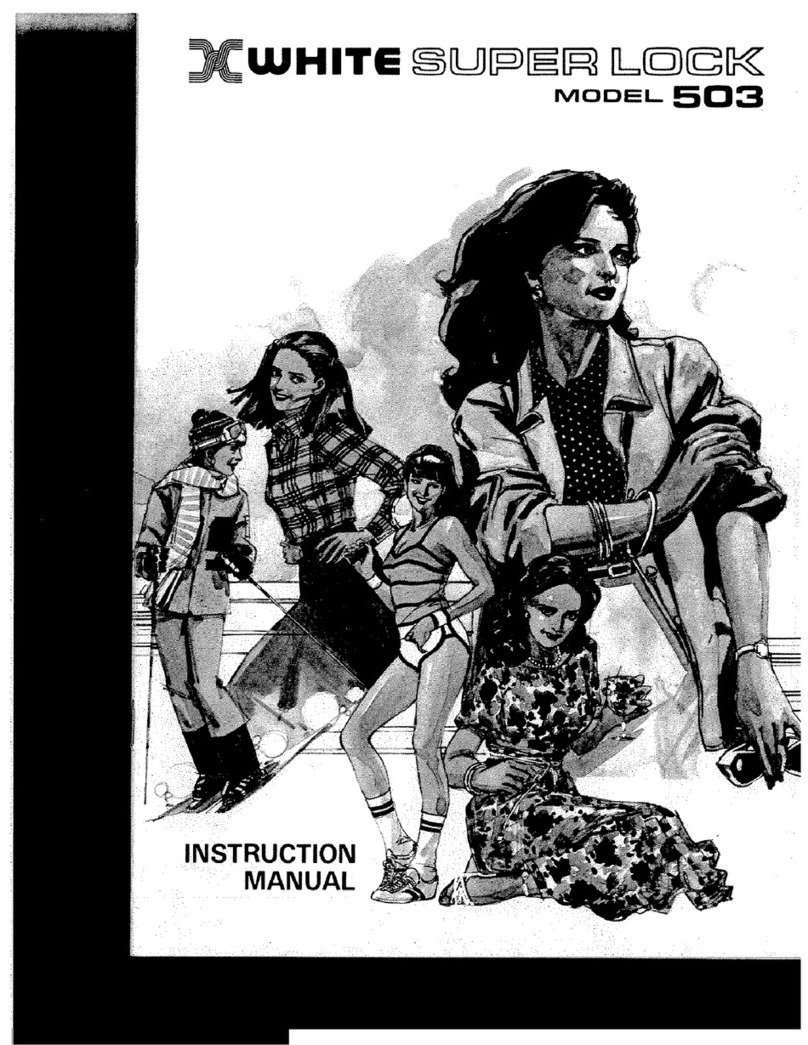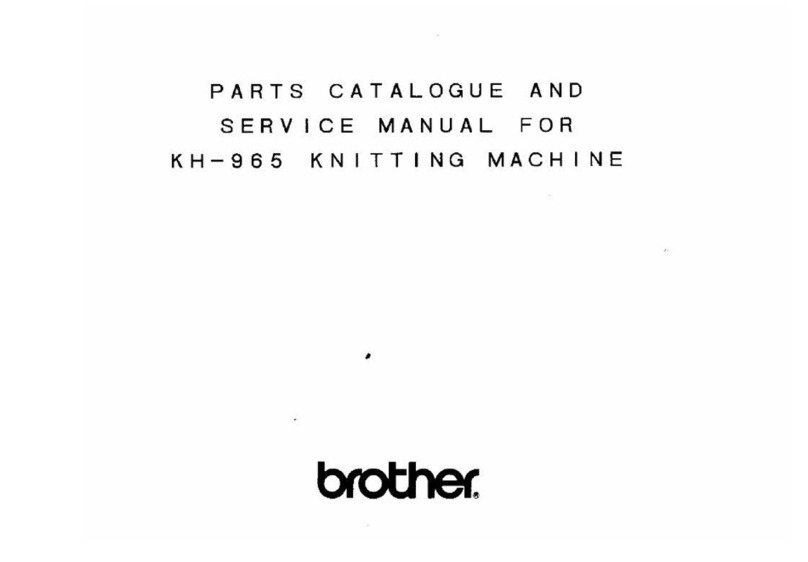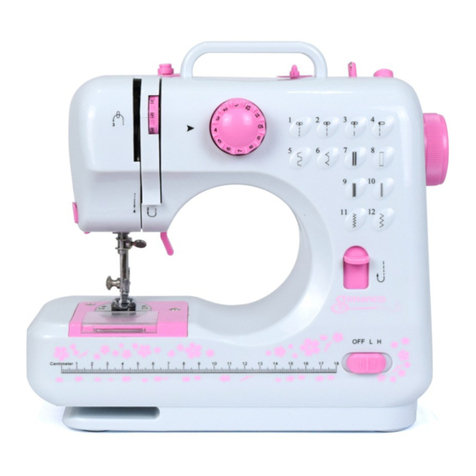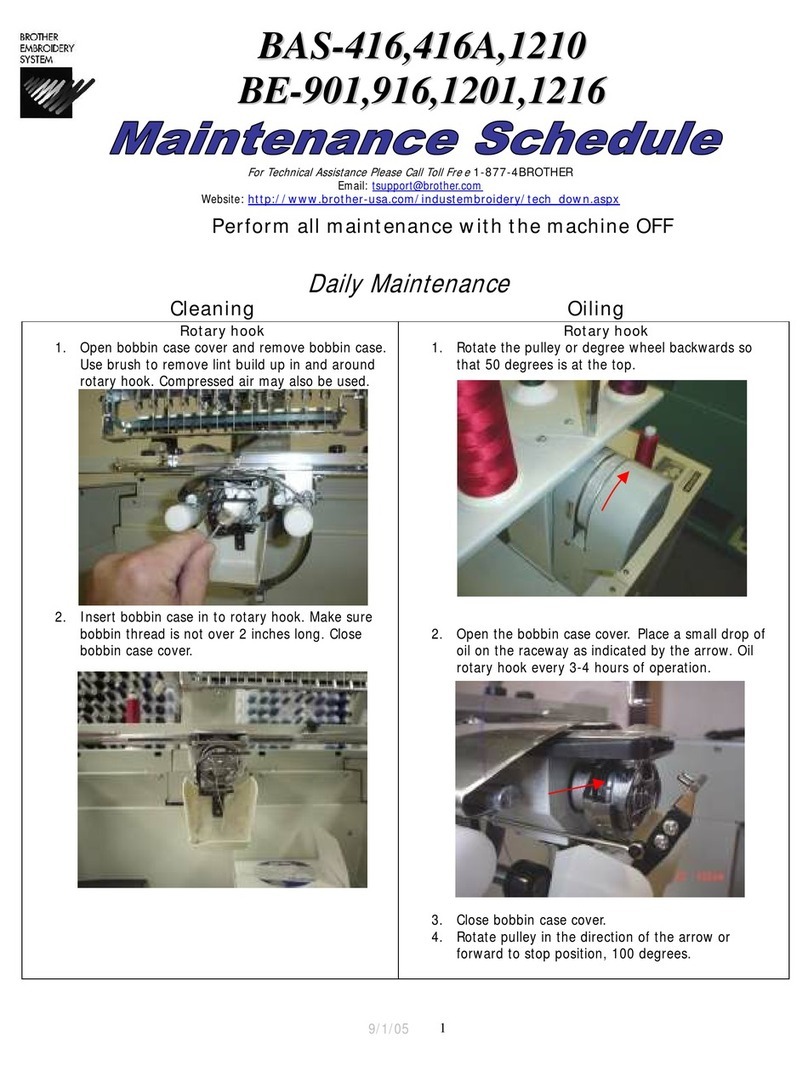Merrylock MK 4055 User manual

INSTRUCTION BOOK
INSTRUCTION BOOKINSTRUCTION BOOK

Do not dispose of electrical appliances as unsorted municipal waste. Use
facilities.
Contact your local government for information regarding the collection systems
available.
If electrical appliances are disposed of in landfills or dumps, hazardous
the groundwater and get into the food chain,
damaging your health and well-being.
When replacing old appliances with new one, the retailer is legally obligated to
appliance for disposal at least for free of charge.
separate collection
substances can leak into
take back your old
Thank you for your purchase of this Combination Overlock, Chain Stitch and Cover Stitch
Sewing Machine. This machine, that is intended for household use will provide you with
excellent performance in sewing from light to heavy material (lawn to denim).
Please refer to this Instruction Book for proper use and optimum service. To get the most
out of your sewing machine, read the entire Instruction Book before attempting to operate
the machine. Then familiarize yourself with the machine by following the Instruction Book
page by page.
To ensure that you are always provided with the most modern sewing capabilities, the
manufacturer reserves the right to change the appearance, design or accessories of this
sewing machine when considered necessary without notification or obligation.
1
PREFACE
RECYCLING

2
“IMPORTANT SAFETY INSTRUCTIONS“
“DANGER“___To reduce the risk of electric shock:
“WARNING“___
When using an electrical appliance, basic safety precautions should always be
followed, including the following: Read all instructions before using this overlock
sewing machine.
1. The appliance should never be left unattended when plugged in.
2. Always unplug this appliance from the electric outlet immediately after using and
before cleaning.
1. Do not allow this appliance to be used as a toy. Close attention is necessary
when this appliance is used by or near children and infirm persons.
2. Use this appliance only for its intended use as described in this manual. Use only
attachments recommended by the manufacturer as contained in this manual.
3. Never operate this appliance if it has a damaged cord or plug, if it is not working
properly, if it has been dropped or damaged, or dropped into water. Return the
appliance to the nearest authorized dealer or service center for examination,
repair, electrical or mechanical adjustment.
4. Never operate the appliance with any air openings blocked. Keep ventilation
openings of the sewing machine and foot control free from the accumulation of
lint, dust, and loose cloth.
5. Keep fingers away from all moving parts. Special care is required around the
sewing machine needle and cutter.
6. Always use the proper stitch plate. The wrong plate can cause the needle to
break.
7. Do not use bent needles.
8. Do not pull or push fabric while stitching. It may deflect the needle causing it to
break.
9. Switch the sewing machine off “ O “ when making any adjustments in the needle
area, such as threading needle area changing needle, threading looper, or
changing presser foot and the like.
10. Always unplug the machine from the electrical outlet when removing covers,
when covers are opened to raise the upper cutter or thread the loopers, when
lubricating or when making any other user servicing adjustments mentioned in
the instruction manual.
11. Never drop or insert any abject into any opening.
12. Do not use outdoors.
13. Do not operate where aerosol (spray) products are being used or where oxygen
is being administered.
14. To disconnect, turn all controls to the off “ O “ position, then remove plug from
outlet.
15. Do not unplug by pulling on cord. To unplug, grasp the plug, not the cord.
16. If the power cord of this appliance is damaged, it must be replaced with a
special cord by your nearest authorized dealer or service center.
To reduce the risk of burns, fire, electric shock, or
injury to persons:

“This overlock sewing machine is intended for household use only.”
you give the machine to a third
may not be able to estimate the
physical, sensory or mental
unless they have been given supervision or instruction
manufactured by Wakaho.
4C-326G/
* Keep the instructions at a suitable place close to the machine and hand it over if
party.
* Use the machine only in dry locations.
* Never leave the machine unattended with children or elderly people due to they
risk.
* Don’t let children play with the machine.
* This appliance is not intended for use by persons (including children) with reduced
capabilities, or lack of experience and knowledge,
concerning use of the
appliance by a person responsible for their safety.
* Children should be supervised to ensure that they do not play with the appliance.
* Always unplug the machine if you leave it unattended, to avoid injury by
expediently switch on the machine.
* Always unplug the machine if you carry out maintenance (oiling, cleaning).
* Don’t use the machine if it’s wet or in humid environment.
* Never pull at the cord, always unplug the machine by gripping the plug.
* Never place anything on the pedal.
* Never use the machine if the air vents are blocked keep the air vents of the
machine and the foot pedal free from dust, fusel and leftovers.
* The machine may only be used with foot pedal Type
4C-316B for USA and Canada, 4C-316C/ 4C-345G for other countries.
* If the supply cord connected with foot pedal is damaged, it must be replaced by the
manufacturer or its service agent or a similarly qualified person, in order to avoid a
hazard.
3
“SAVE THESE INSTRUCTIONS“
17. If oil gets in eyes, immediately, rinse the oil out with water. If you swallow oil by
mistake, immediately consult a medical doctor.
20. To reduce risk of injury, switch off before servicing. Close looper cover before
operating.

Lors de l’utilisation de cette machine, les précautions élémentaires de sécurité
doivent être pris es. Lisez attentivement toutes les consignes de sécurité suivantes
avant de l’utiliser :
* Ne laissez pas la machine sans surveillance lorsqu’elle est sous tension.
Débranchez la immédiatement après l’utilisation et avant le nettoyage.
* Débranchez la machine avant de changer l’ampoule. Remplacer l’ampoule par une
autre de 15 Watts et du même type. Assurez vous d’avoir remis le cache après
avoir changé l’ampoule.
* Assurez vous que le voltage du moteur corresponde à celui de l’installation
électrique.
* Cette machine est conçue pour un usage familial tel que décrit dans cette notice
d’utilisation. Utilisez uniquement les accessoires conseillés dans cette notice.
* Pour débrancher la machine positionnez l’interrupteur sur«O»lorsque vous
effectuez des opérations telles que enfilage des aiguilles ou des boucleurs ,
changement de plaque à aiguille ou de pied presseur etc....
* Débranchez la machine lorsque vous retirez les carters , lubrifiez le mécanisme ou
lors de toute opération d’entretien décrite dans cette brochure.
* N’essayez pas de régler vous-même la courroie du moteur. Si un réglage s’avère
nécessaire, contactez votre Service Après Vente .
* Manipulez le rhéostat avec précaution et évitez de le faire tomber. Assurez-vous
que rien n’est posé dessus.
* Utilisez la plaque à aiguille adéquate. Une plaque non conforme pe ut casser
l’aiguille.
* N’utilisez pas d’aiguille tordue.
* Lors de la couture, éloignez vos doigts de toute pièce en mouvement et
particulièrement de l’aiguille.
* Ne tirez et ne poussez pas le tissu lors de la couture, cela pourrait casser l’aiguille.
* Pour l’entretien des machines à double isolation, n’utilisez que des pièces de
rechange identique . Voir les instructions pour le service après-vente des appareils
à double - isolation.
* Ne jamais utiliser la machine si le cordon ou la prise électrique sont endommagés,
si elle est tombée ou abîmée, si elle a été exposée à l’eau. Contactez votre
Service Après Vente pour tout examen , réglage ou réparation.
* N’utilisez pas la machine si les aérations ou le rhéostat sont obstrués par la
poussière, la bourre de fil ou de tissu.
* N’insérez ou ne faîtes pas tomber d’objets dans les ouvertures de la machine.
Pour réduire le risque de blessures, éteindre l'interrupteur avant l'entretien. Fermer
le couvercle boucleur avant exploitation.
*
CONSIGNES DE SECURITE
4
DANGER - Pour reduire le risque de décharges électriques :
AVERTISSEMENT - Pour réduire le risque de brûlures, de feu, de
ou de blessures Aux personnes :décharges électriques

1. PRINCIPAL PARTS
(1) MACHINE OVERVIEW
(2) FREE ARM
(3) MAIN PARTS BEHIND THE LOOPER COVER
2. ACCESSORIES
3. OPTIONAL ACCESSORIES
(1) COVER STITCH PRESSER FOOT
(2) EXTENSION TABLE SET
4. NEEDLE INFORMATION
5. PREPARATION PRIOR TO SEWING
6. TELESCOPIC THREAD STAND
7. PREPARATION FOR THREADING
(1) SETTING UP THE THREAD GUIDE HOLDER
(2) ANTI-SPILL NET
(3) SPOOL CAP
8. REMOVAL AND REPLACEMENT OF CHIP BOX
(1) REPLACEMENT
(2) REMOVAL
9. HOW TO REMOVE AND INSERT NEEDLES
(1) NEEDLE POSITION
(2) TO REMOVE NEEDLE (S)
(3) TO INSERT NEEDLES (S)
10. PRESSER FOOT LIFT
11. CHANGE PRESSER FOOT
12. GENERAL THREADING INFORMATION
(1) TO THREAD CHAIN STITCH/ COVER STITCH
LOOPER THREAD (BROWN)
(2) TO THREAD COVER STITCH RIGHT NEEDLE
(GREEN) (E ON NEEDLE CLAMP)
(3) TO THREAD COVER STITCH MIDDLE /
CHAIN STITCH NEEDLE THREAD (BLUE)
(D ON NEEDLE CLAMP)
(4) TO THREAD COVER STITCH LEFT NEEDLE
THREAD (ORANGE) (C ON NEEDLE CLAMP)
5
13. NEEDLE THREADER
14. HOW TO CHANGE THREADS : TIE ON METHOD
15. STITCH LENGTH ADJUSTMENT
16. SELECTION OF STITCHES
17. STITCH OVERVIEW
18. COVER STITCH SEWING
(1) MACHINE SET UP
(2) SECURING THE COVER STITCH SEAM END
19. PRESSER FOOT PRESSURE ADJUSTMENT
20. DIFFERENTIAL FEED
(1) TO SET THE DIFFERENTIAL FEED ADJUSTING
DIAL FOR GATHERING
(2) TO SET THE DIFFERENTIAL FEED ADJUSTING
DIAL FOR STRETCH
21. HOW TO SEW A COVER STITCH
(1) MACHINE SET UP
(2) ADDITIONAL INFORMATION ABOUT COVER
STITCH
22. SUGGESTED TENSION SETTING
(1) CHAIN STITCH
(2) COVER STITCH, WIDE AND (3) COVER STITCH,
NARROW
(4) COVER STITCH, TRIPLE
23. MACHINE MAINTENANCE
(1) CLEANING
(2) STORAGE
(3) SERVICING
24. TROUBLE SHOOTING
25. SPECIFICATIONS
26. MACHINE DIMENSIONS
6
6
7
8
8
9
9
9
10
10
11
11
11
11
12
12
12
12
13
13
13
14
14
14
15
15
17
18
19
21
22
22
23
23
24
24
24
25
25
25
25
26
27
28
28
28
29
29
29
30
30
30
31
31
TABLE OF CONTENTS
PAGE PAGE

6
1. PRINCIPAL PARTS
(1) MACHINE OVERVIEW
1. Thread guides and holder
2. Handle
3. Left needle thread tension fine tuning (orange)
4. Right needle thread tension fine tuning (blue)
5. Upper looper thread tension fine tuning (green)
6. Chain stitch looper thread tension fine tuning (brown)
7. Stitch plate
8. Cloth plate
9. Attached extension table
10.
12. Power & light switch
13. Hand wheel
14. Differential feed adjusting dial
15. Stitch length dial
16. Spool stand
17. Spool holder
18. Spool pin
19.
Cutter cover B
11. Looper cover
Presser bar lifter and tension release
20. Auto tension dial
2
1
7
11
12
15
13
16
17
18
6
45
3
14
10
8
9
19
20

7
21. Foot pressure adjusting dial
22. Thread cutter
(2) FREE ARM
1. Attached extension table
* The attached extension table can be removed to expose the free arm.
* To remove pull to the left.
* To attach press firmly to the right until it engages.
* The free arm is ideal for sewing tubular items such as ribbing, trousers and sleeve hems.
1
21
22

8
2. ACCESSORIES
Accessories No. 1~10 are contained in the accessory box.
1. Flat blade screw driver
2. Oiler
3. Brush
4. Needle set
5. Anti-spill net (4)
6. Upper cutter
7. Thread unwinding spool cap (4)
8. Needle threader
(3) MAIN PARTS BEHIND THE LOOPER COVER
1. Cover stitch looper thread take-up lever (D)
2. Cover stitch looper thread take-up lever (E)
3. Chain looper thread guide set
4. Cover looper protect board
5. Spring
6. Cover looper autothreader
7. Cover looper
9. Screw driver
10. Tweezers
11. Accessory box
12. Spool holder (4)
13. Dust cover
Note : No. 8~10 commonly used accessories can place on looper cover, sewing will be more convenient.
11 13
12
12710
36
5
49
8
4
5
3
2
6
3
1
7

3. OPTIONAL ACCESSORIES
Optional presser feet specially prepared for this machine are available at your dealer. The snap-on type
presser foot used on this machine allows easy removal and replacement.
(2) EXTENSION TABLE SET
Extension Table Set J11862
Including extension table, four legs and push pin. Assemble the extension table
and legs according to the illustrations provided with the table. The push pin is
used in the small holes in the table to hold your fabric in place when sewing
circles.
(1) COVER STITCH PRESSER FOOT
9
Elastic Foot G20804A
The Elastic Foot guides and stretches narrow elastic (6-12mm, 1/4~1/2”) wear
lingerie and other elastic insertion techniques
,
.
Cover Hem Foot H10803
With the Cover Hem Foot, you can see your fabric and marked line under the
foot as you sew.
Flat lace foot H10813
With the Flat Lace Foot, you can easily add lace and trims to the top of the
fabric with a cover stitch to create beautiful decorative edges and effects.
Cording Foot Set H10793
With the Cording Foot with Cording Guide, you can create piping, corded tucks
and decorative trims.
Hemming Foot H10833
With the Hemming Foot makes hems more easily. Just insert the fabric into
fabric guide with the folded side down and slide fabric into guide under foot to
needle.
Bias Tape Folder Foot H10843
With the Bias Tape Folder Foot, create straps and belt loops easily using a
cover stitch. Just put a strip into the foot and the strip is folded automatically
and stitched in place.
Bias Tape Binding Foot
Use t
H10823
he Bias Tape binding Foot to sew bias tape along edge of fabric
.
more
easily
Flat Edge Lace Foot H10853
Use the Flat Edge Foot to hem the fabric edge and attach lace at the same
time.

10
Use only foot controller provided with this machine.
(Type 4C-316B for U.S.A. & CANADA only)
5. PREPARATION PRIOR TO SEWING
* Connect the controller/electric plug to the machine
receptacle.
* Plug power line into electric outlet.
* Power Switch: Push"l"mark side to turn "ON”
Push "O" mark side to turn "OFF”
* To run the machine and control the speed, press
the controller.
* The harder you press, the faster the machine will
sew.
* To stop the machine from sewing, remove your
foot from the controller.
POLARIZED PLUG INFORMATION (FOR U.S.A. & CANADA ONLY)
This appliance has a polarized plug (one blade wider than the other). To reduce the risk of electric shock, this
plug is intended to fit in a polarized outlet only way. If the plug does not fit fully in the outlet, reverse the plug.
If it still does not fit contact a qualified electrician to install the proper outlet. Do not modify the plug in any way.
* Be sure that the electrical voltage of the electric outlet (wall receptacle) is the same as the rated voltage of
the motor.
* Handle the foot controller with care and avoid dropping it on the floor. Be sure not to place anything on top
of it when not in use.
* Disconnect the power line plug from the electric outlet when changing needles, presser feet or when
leaving the machine unattended. This eliminates the possibility of starting the machine by accidentally
pressing the controller.
4. NEEDLE INFORMATION
This overlock uses a flat shank industrial needle
that eliminates the possibility of inserting the needle
backwards.
Do not attempt to use a standard household sewing
machine needle of any size or type in this overlock.
Needle ELx705 size 14/90 is finished with the
machine.
Only use Needle ELx705 size 14/90 and 12/80 as
supplied in the accessory case.
ELx705
Overlock needle

11
7. PREPARATION FOR THREADING
(1) SETTING UP THE THREAD GUIDE
HOLDER
* This machine is shipped with the thread guide
holder on the top of Styrofoam.
* Fully extend the thread guide holder.
* The two joints on the telescope will click into place
when they are correctly positioned.
* Center the thread guides above the spool pins.
* Place thread over the cone adapters on the spool
pins.
Note : Your new machine is threaded to sew Triple
Cover Stitch. Refer to Page 15 for
instructions on tying on to the threads.
Anti-spill net
(2) ANTI-SPILL NET
*When using synthetic threads that easily spill off
the cone, slip the anti-spill net furnished with the
machine over the thread from the bottom of the
cone leaving the thread end hanging free at the
top the anti-spill net as shown at right.
6. TELESCOPIC THREAD STAND
* Place the thread spools over the cone holders on
the spool pin.
* If the machine is already threaded, straighten the
threads to prevent tangling.
1
2

12
8. HOW TO OPEN AND CLOSE LOOPER
COVER
(1) OPEN LOOPER COVER
* Push the looper cover to the right as far as it will
go.
* Pull looper cover down toward you.
* First pull the looper cover upward and then slide it
to the left until it locks.
Note : The looper cover has a safety switch and the
machine will not sew if the looper cover is
open.
(2) CLOSE LOOPER COVER
(3) SPOOL CAP
Spool cap
Thread spool
Press in
*When using a regular thread spool, fit the spool
cap supplied with the machine onto the thread
spool as shown at right.
Be sure to turn off power switch.
Be sure looper cover is closed when sewing.
1
2

EDC
Cover stitch right needle
Cover stitch middle needle
/ Chain stitch needle
Cover stitch left needle
Be sure to disconnect the machine from the
electric outlet before removing needle(s).
Chain stitch needle thread
Left, middle and right cover
stitch needle thread
Flat surface to the rear
(1) NEEDLE POSITION
* With this machine, five needles can be inserted to
the needle clamp as shown in the drawing but
only one or two or three needles are to be used
for cover stitch sewing.
Note : Do not attempt to use four or five needles.
* The Instruction Book refers to different needle
positions by illustrating the needle clamp at right.
Note : When all cover stitch needles are inserted,
the left needle will be slightly higher than the
others.
1
(2) TO REMOVE NEEDLE (S)
9. HOW TO REMOVE AND INSERT
NEEDLES
* Turn the hand wheel toward you until the needles
are
the
the fabric.
* Loosen, but do not remove the needle clamp
screw with the allen key while you are holding the
needles.
C. Cover stitch left needle
D. Cover stitch middle needle
E. Cover stitch right needle
at their highest position.
* Place a thick piece of fabric [such as felt] under
presser foot. Lower the needles halfway into
Note: After removing the specific needle which is
not currently to be used for sewing, remember to
fasten the set screw in the screw hole of the needle
clamp and to just fasten tight into the hole.
Please do not over-tighten the screw into the hole
or the needle clamp will be damaged.
13
C
E
D
D
C
E
D

To loosen
To tighten
(3) TO INSERT NEEDLES (S)
* Hold the needle with the flat surface to the back.
* Insert the needle into the needle socket as far as
it will go.
* When inserting a needle, if you first lower it down
into the hole in the stitch plate it will line up with
the needle socket. Then direct it upwards.
This machine uses ELx705 needles. Do not use
Standard Household Needles.
14
* Raise the presser foot.
* Turn the hand wheel toward you until the needles
are at the highest position.
* Push the red button on the back of the presser
foot ankle to release the presser foot.
* Raise the presser foot to the extra lift position and
the foot will come off.
* Place the new foot with the pin right underneath
the groove of the ankle while in the extra lift
position.
* Lower the presser foot. Push the red button on the
back of the presser foot ankle and the foot will
snap into place.
11. CHANGE PRESSER FOOT
Turn off the main power switch and unplug
the machine.
10. PRESSER FOOT LIFT
* Raise the presser foot by raising presser foot lift
lever at the right side of the machine.
* Raising up the presser foot lift puts the presser
foot in the extra lift position.

41
32
15
*Thread the machine in the order 1 to 4 as shown
at right.
Note : Threads go through the take-up lever cover
for Chain stitching as shown.
threads to
them through
your new
Tip : Your new machine is threaded to sew a
standard “Triple Cover Stitch”. Tie your own
these threads and carefully pull
the machine, to easily thread
Triple Cover Stitch machine the first
time.
12. GENERAL THREADING INFORMATION
(1) TO THREAD
(BROWN)THREAD
* Thread the chain stitch/cover stitch looper as
indicated 1~12.
* Raise Presser foot to release Tension discs.
* Pass thread from back to the front through the
thread guide 1.
CHAIN STITCH/ COVER
STITCH LOOPER
* Thread the top cover thread guide by pulling the
thread towards the right until it slips under guide.
Then pull thread along the right side of button as
illustrated.
1
2
3
1
4
5
7
8
6
9
10
12
11
2
2

10cm
(4")
* While holding thread with fingers, pass it between
the tension discs and pull thread down to make
certain it is properly located in between the
tension discs 3.
16
3
3
* Turn the hand wheel toward you until the cover
stitch looper extends out 10mm from the stitch
plate edge.
* Thread the looper area of the machine following
the brown color-coded thread guides 4~12.
Note : Use the tweezers provided in the accessory
case to aid in threading the looper.
* Place the thread with the point of the tweezers
through threading guide 4~7.
* Thread the Chainstitch
thread guide (8) by holding
the thread in front of the
thread guide pin and pulling
the thread backward and
up, until the thread rests
inside the thread guide loop
and under the spring.
* Position thread through in guide 9. Pull thread in
front the board and through guide 10.
* Thread the looper eye 12 from front to back. Pull
about 10cm (4 inches) of thread through the
looper.
* Press down the threader guide board (A) and pull
to the right side out.
* Release the threader guide board (A) that
automatically spring back and pull thread into
guide 11 and make sure the threader guide board
(A) to the leftmost point.
4
4
5
6
7
8
9
10
12
11
8
10
12
9
11
A
A
12

(2) TO THREAD
(GREEN) (E ON NEEDLE CLAMP)
*
* Pass thread from back to the front through the
thread guide 1.
* Thread the top cover thread guide by pulling the
thread towards the right until it slips under guide.
Then pull thread along the right side of button as
illustrated.
* While holding thread with fingers, pass it between
the tension discs and pull thread down to make
certain it is properly located in between the
tension discs 3.
Thread the right needle as indicated 1~10.
* Raise Presser foot to release Tension discs.
COVER STITCH RIGHT
NEEDLE
17
3
4
5
6
7
8
9
10
1
2
1
2
2
3
3

* Continue to thread points 4~9.
* Slip the thread into the rear slot on the thread
guide (5) and into the slot on the take-up lever
cover (6). Then slip the thread into the right slot
on the thread guides (7) and (8).
* Before threading the eye of the needle, make sure
thread is in front of thread guide located on the
bottom of the needle clamp (9).
* Thread the eye of the needle. Use the needle
threader (page 21) to make the threading easier.
* Pull about 10 cm (4") of thread through needle
eye to hang free.
* Place the thread to the back, under the presser
foot.
* Thread the cover stitch middle / chain stitch
needle as indicated 1~10.
* Raise Presser foot to release Tension discs.
* Pass thread from back to the front through the
thread guide 1.
* Thread the top cover thread guide by pulling the
thread towards the right until it slips under guide.
Then pull thread along the right side of button as
illustrated.
(3) TO THREAD
THREAD (BLUE)
(D ON NEEDLE CLAMP)
COVER STITCH MIDDLE /
CHAIN STITCH NEEDLE
18
4
5
6
7
8
9
10
5
3
4
5
6
7
8
9
10
1
2
1
2
2

* While holding thread with fingers, pass it between
the tension discs and pull thread down to make
certain it is properly located in between the
tension discs 3.
* Continue to thread points 4~9.
* Slip the thread into the rear slot on the thread
guide (5) and into the slot on the take-up lever
cover (6). Then slip the thread into the right slot
on the thread guides (7) and (8).
* Before threading the eye of the needle, make sure
thread is in front of thread guide located on the
bottom of the needle clamp (9).
* Thread the eye of the needle. Use the needle
threader (page 21) to make the threading easier.
* Pull about 10 cm (4") of thread through needle
eye to hang free.
* Place the thread to the back, under the presser
foot.
19
3
4
5
6
7
8
9
10
5
3
3
4
5
6
7
8
9
10
1
2
(4) TO THREAD
THREAD (BLUE)
(D ON NEEDLE CLAMP)
* Thread the cover stitch middle / chain stitch
needle as indicated 1~10.
* Raise Presser foot to release Tension discs.
COVER STITCH MIDDLE /
CHAIN STITCH NEEDLE
This manual suits for next models
1
Table of contents
Other Merrylock Sewing Machine manuals
